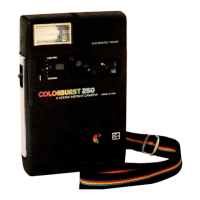3.
Frame your
subject
in the
viewfinder
.
Hold the camera steady and depress the
shutter release smoothly to take the pic-
ture. The camera
motor
will
eject
the
print
as you
allow
the shutter release to return.
When the ready
light
begins to blink again,
you are ready
for
another flash
picture
.
NOTE:
For best results when you take
pic-
tures of
subjects
that are more than 7 feet
from the camera,
it's
a good idea to wait
an
additional
30
seconds after the ready
light
begins to
blink
.
4. To turn the flash
unit
off
,
slide
it
toward
the camera body until it stops.
NOTE:
To conserve battery power, push
the
unit
to its
off
position whenever you
don't
expect
to be taking flash pictures for
a few minutes. Always store the camera
with the unit pushed to its off position.
Loss of battery power affects the exposure
control, the camera motor, and the flash.
See WARNING on page
15.
Minimizing Eye Reflections
When you take flash pictures, people's
eyes sometimes appear red. The red is
produced by reflections from the retina of
the
eye. This effect is especially notice-
able when
your
subject
is young, has a
light
complexion
,
or
has blue
eyes-also
when your
subject
is in a
dimly
lighted
place.
To help reduce these reflections, you
can
(1)
turn on
additional
room lights, and
(2) have your
subject
look
directly
at one
of the room lights. This
will
cause the
pupils of the eyes to contract, reducing
the reflections.
6
For the most pleasing
vertical-format
flash
pictures, hold the camera as shown here.
This positions the flash above the lens to
help
prevent unusual shadows on
your
subject
and the
background
.
Fill-in Flash
You can often use
your
flash to improve
outdoor
pictures, especially when your
subject
is in shadow
or
when
sunlight
is
striking
the
subject
so that it casts shad-
ows on the
subject's
face. The use of flash
also allows you to turn your
subject's
face
away from the sun to eliminate squinting
and bring
out
natural, relaxed facial ex-
pressions. Flash
is
helpful in obtaining bet-
ter
exposure on
cloudy
days as well.
Always remember to keep
your
subject
within
the recommended flash range.

